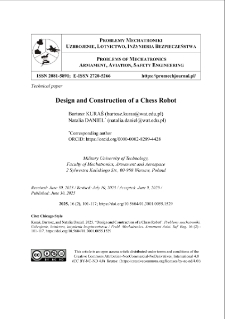Nasza Biblioteka Cyfrowa udostępnia 1 868 obiektów cyfrowych
Obiekt
Tytuł: Design and Construction of a Chess Robot ; Design and Construction of a Chess Robot
Tytuł odmienny:
Projekt i wykonanie robota szachowego ; Projekt i wykonanie robota szachowego
Współtwórca:
Natalia DANIEL ; Natalia DANIEL
Abstrakt:
This work aims to present the design and development process of a voice-controlled chessboard equipped with a mechanism for moving chess pieces. The article explores different chessboard games that can be automated, incorporating various control methods such as voice commands and autonomous robotic systems. The authors implemented a mechanism located beneath the chessboard to move the pieces, which they deemed more practical and safer for the user. This approach also enables a more natural movement of the pieces, which appeals to players. The system’s key components include the Arduino Mega microcontroller, stepper motors, and a voice recognition module. The movements are controlled through voice commands. In constructing the mechanism, elements made using additive techniques, along with linear guides and bearings were utilised. All moves are controlled by an algorithm that calculates the positions and checks whether they comply with the rules of chess. The key design considerations were lightweight construction, accurate piece movement, quiet operation, and voice recognition. The main goal was a device that could be easily replicated by those with the necessary technical expertise. The result is a voice-controlled chessboard, capable of captivating both novice and experienced chess players alike.
;
This work aims to present the design and development process of a voice-controlled chessboard equipped with a mechanism for moving chess pieces. The article explores different chessboard games that can be automated, incorporating various control methods such as voice commands and autonomous robotic systems. The authors implemented a mechanism located beneath the chessboard to move the pieces, which they deemed more practical and safer for the user. This approach also enables a more natural movement of the pieces, which appeals to players. The system’s key components include the Arduino Mega microcontroller, stepper motors, and a voice recognition module. The movements are controlled through voice commands. In constructing the mechanism, elements made using additive techniques, along with linear guides and bearings were utilised. All moves are controlled by an algorithm that calculates the positions and checks whether they comply with the rules of chess. The key design considerations were lightweight construction, accurate piece movement, quiet operation, and voice recognition. The main goal was a device that could be easily replicated by those with the necessary technical expertise. The result is a voice-controlled chessboard, capable of captivating both novice and experienced chess players alike.
Miejsce wydania:
Warszawa
;
Warszawa
Wydawca:
Wojskowa Akademia Techniczna ; Wojskowa Akademia Techniczna
Data utworzenia:
Data złożenia:
Data akceptacji:
Data wydania:
Rozmiar:
Identyfikator:
oai:ribes-88.man.poznan.pl:2739
Sygnatura:
doi:10.5604/01.3001.0055.1529 ; doi:10.5604/01.3001.0055.1529
ISSN elektroniczny:
ISSN drukowany:
Język:
Licencja:
kliknij tutaj, żeby przejść ; kliknij tutaj, żeby przejść
Właściciel praw:
Wojskowa Akademia Techniczna ; Wojskowa Akademia Techniczna
Strona początkowa:
Strona końcowa:
Tom:
Czasopismo:
Słowa kluczowe:
chess, robot, voice recognition ; chess, robot, voice recognition
Kolekcje, do których przypisany jest obiekt:
Data ostatniej modyfikacji:
17 paź 2025
Data dodania obiektu:
17 paź 2025
Liczba wyświetleń treści obiektu:
0
Wszystkie dostępne wersje tego obiektu:
https://ribes-88.man.poznan.pl/publication/3080
Wyświetl opis w formacie RDF:
Wyświetl opis w formacie OAI-PMH:
| Nazwa wydania | Data |
|---|---|
| Design and Construction of a Chess Robot | 17 paź 2025 |

